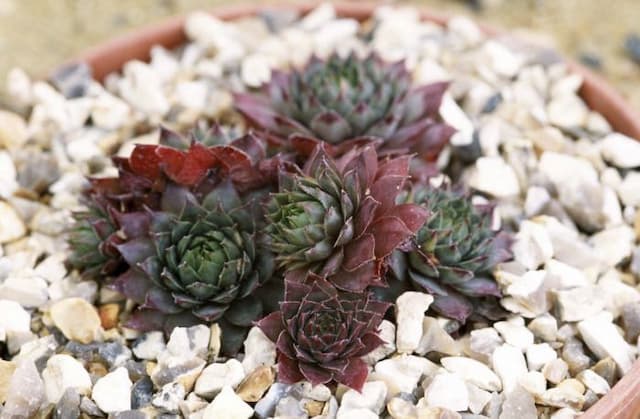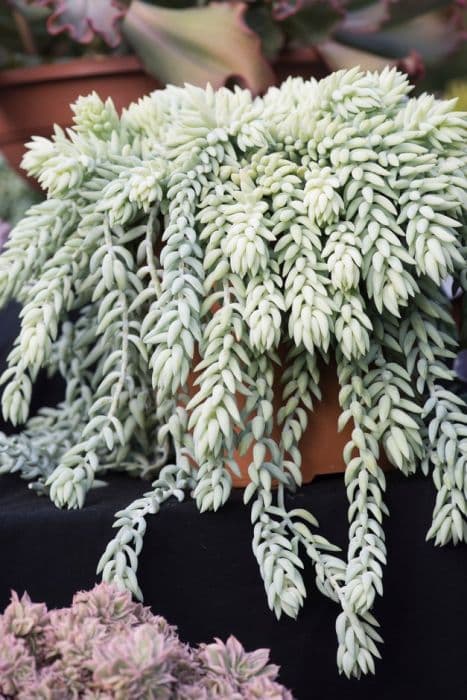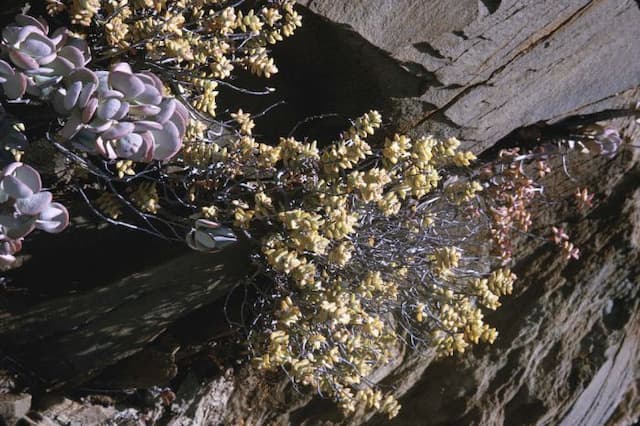Bonsai Crassula Crassula sarcocaulis

ABOUT
Crassula sarcocaulis, commonly known as "Bonsai Crassula," is an attractive succulent that bears a distinct appearance reminiscent of a miniature tree. Its trunk is thick and woody with a bark that can appear reddish-brown, lending it a rugged, aged look much like that of a bonsai. The branches are densely arranged and may spread outward in a manner that creates a full, lush canopy. The leaves of the Bonsai Crassula are small, plump, and glossy, with a bright green color that contrasts nicely against the woody stems. They are oval-shaped and often have rounded tips, and they grow in opposing pairs along the stems. During the flowering season, the Bonsai Crassula blooms with small, star-shaped flowers that can range in color from white to pink. These little, aesthetic blossoms cluster at the ends of the branches, adding a delicate touch to the plant's robust form. The overall impression is one of a natural, dwarf tree, often prized by enthusiasts for its graceful, sculptural qualities that make it a favorite in rock gardens, as a potted specimen, or in collections of succulent plants. It is also well-regarded for its low maintenance and drought-tolerant nature, making it a suitable choice for both beginners and seasoned plant enthusiasts.
About this plant
 Names
NamesFamily
Crassulaceae
Synonyms
Bonsai Crassula, Beestebul
Common names
Crassula sarcocaulis.
 Toxicity
ToxicityTo humans
Crassula sarcocaulis, commonly known as bonsai crassula, is not widely recognized as a toxic plant to humans. There is limited information on its toxicity, as it is primarily grown for ornamental purposes, and its ingestion is not common. Therefore, it does not have a well-documented history of causing poisoning in humans. If you suspect poisoning from any plant, it is important to seek medical advice.
To pets
Bonsai crassula is not generally known to be toxic to pets. However, it is always possible that some animals might have a sensitivity or allergic reaction to plants that are not widely recognized as toxic. If you observe any unusual symptoms in your pet after ingestion, such as vomiting, diarrhea, or lethargy, it's advisable to consult with a veterinarian.
 Characteristics
CharacteristicsLife cycle
Perennials
Foliage type
Evergreen
Color of leaves
Green
Flower color
Pink
Height
2-3 feet (60-90cm)
Spread
2-3 feet (60-90cm)
Plant type
Succulent
Hardiness zones
9
Native area
South Africa
Benefits
 General Benefits
General Benefits- Decorative: Crassula sarcocaulis, commonly known as bonsai crassula, is an attractive succulent that adds visual interest to gardens, homes, and offices with its tree-like appearance.
- Drought Tolerance: Being a succulent, bonsai crassula is highly drought-resistant, requiring minimal watering and care, making it ideal for xeriscaping and low-water gardens.
- Easy Propagation: This plant is easy to propagate from cuttings, allowing gardeners to easily expand their collection or share with others.
- Low Maintenance: Bonsai crassula requires minimal care beyond occasional watering and pruning, making it suitable for those with busy lifestyles or beginners in gardening.
- Compact Size: Its relatively small size makes it perfect for cultivation in containers, on windowsills, or in confined spaces.
- Stress Relief: The practice of caring for and pruning bonsai crassula can be a relaxing and stress-relieving hobby.
 Medical Properties
Medical PropertiesThis plant is not used for medical purposes.
 Air-purifying Qualities
Air-purifying QualitiesThis plant is not specifically known for air purifying qualities.
 Other Uses
Other Uses- Crassula sarcocaulis, commonly known as bead vine, can be used in miniature gardens or fairy gardens due to its small size and attractive, branching form.
- The plant's unique texture and form make it suitable for creating intricate bonsai arrangements and cultivating the practice of patience and plant grooming.
- Incorporating bead vine in terrariums can add a touch of greenery and interesting structure to these small enclosed ecosystems.
- This plant is sometimes used as a living mulch in succulent collections, covering the soil and helping to retain moisture due to its thick leaves.
- Bead vine can serve as a natural artistic subject for photographers and painters who are inspired by its interesting shape and textures.
- Its resistance to drought makes it a suitable plant for xeriscaping in arid regions, helping to reduce water use in landscaping.
- Crassula sarcocaulis, when planted in outdoor rock gardens, can help to prevent soil erosion with its root system.
- It can be used in educational settings, such as schools or workshops, to teach about succulent care and propagation techniques.
- The plant can play a role in enhancing the ambience of boutique shops, cafes, and other small businesses with its understated elegance.
- Bead vine can be used in zoos or animal enclosures (where appropriate) to recreate a natural habitat for desert-dwelling creatures.
Interesting Facts
 Feng Shui
Feng ShuiThe Bonsai Crassula is not used in Feng Shui practice.
 Zodiac Sign Compitability
Zodiac Sign CompitabilityThe Bonsai Crassula is not used in astrology practice.
 Plant Symbolism
Plant Symbolism- Resilience: Crassula sarcocaulis, commonly known as Bonsai Crassula, is a succulent plant that can thrive in harsh, arid conditions, symbolizing the ability to endure and overcome difficulties.
- Prosperity: As a member of the Crassula genus, Bonsai Crassula is often associated with wealth and prosperity, making it a popular plant in feng shui practices.
- Longevity: The Bonsai Crassula can live for many years with proper care, representing longevity and the wish for a long life.
- Peace: Its appealing aesthetic and the fact that it is often shaped in the form of a bonsai tree lends a peaceful and tranquil feel to any environment, symbolizing harmony and calm.
- Friendship: Given as a gift, Bonsai Crassula is said to signify enduring friendship, representing the plant’s hardy nature and long lifespan.
 Water
WaterThe bonsai Crassula, commonly known as bonsai Crassula, prefers a thorough watering and then a period to dry out between waterings. Water it until water flows freely from the drainage holes, but don’t let it sit in water as this can lead to root rot. In general, watering every 1-2 weeks should be sufficient, but always check the top inch of soil for dryness before watering again. Reducing watering frequency during the winter months, when the plant is not actively growing, is important. Use approximately 8-16 ounces of water per watering session, depending on the size of the plant and pot, ensuring even distribution throughout the soil.
 Light
LightThe bonsai Crassula thrives in bright, indirect sunlight, making a spot near a south-facing window with a sheer curtain ideal to filter the light. This succulent can also tolerate direct morning light but needs protection from the intense afternoon sun to prevent leaf scorch. However, it is adaptable and can do well under artificial grow lights if natural bright light is not available.
 Temperature
TemperatureBonsai Crassula prefers temperatures between 60-75°F, which are typical room temperatures, making them suitable for indoor growth. They can tolerate a short period of colder temperatures down to 50°F but should not be exposed to frost, which could be damaging. During summer, ensure the plant is kept in a cooler area if indoor temperatures rise significantly above 80°F.
 Pruning
PruningPrune bonsai Crassula to maintain its shape, remove any dead or damaged foliage, and encourage a compact, bushy growth habit. The best time for pruning is in the spring or early summer when the plant is actively growing. Light pruning can be done throughout the year as needed, but always use clean, sharp tools to make precise cuts, and never remove more than one-third of the plant at a time to avoid stressing it.
 Cleaning
CleaningAs needed
 Soil
SoilThe Bead Vine prefers a well-draining soil mix consisting of one part potting soil, one part coarse sand, and a handful of perlite or pumice. The ideal soil pH for Bead Vine is slightly acidic to neutral, ranging from 6.0 to 7.5.
 Repotting
RepottingBead Vine should be repotted every 2 to 3 years or when it outgrows its container. Ensure fresh soil mix is used during each repotting to maintain health and vigor.
 Humidity & Misting
Humidity & MistingBead Vine thrives in average room humidity levels, ranging from 40% to 50%. Protect the plant from extremely high humidity levels to prevent rot and fungal diseases.
 Suitable locations
Suitable locationsIndoor
Place Bead Vine in bright, indirect light and water sparingly.
Outdoor
Grow Bead Vine in partial shade and protect from harsh sun.
Hardiness zone
9-11 USDA
 Life cycle
Life cycleCrassula sarcocaulis, commonly known as bonsai crassula, begins its life cycle as a seed, typically germinating in warm and moist conditions favorable for most succulent plants. Once germinated, the seedling emerges and starts developing succulent leaves, storing water for the dry periods characteristic of its native habitat. As it matures, it forms a woody stem resembling a bonsai tree, which is where its common name derives from. The bonsai crassula enters an adult stage, producing clusters of small, star-shaped flowers, usually in the colors white or pink, attracting pollinators for reproduction. After pollination, seeds are produced, completing the cycle. This plant can also propagate vegetatively from stem or leaf cuttings, leading to new plants that skip the seed stage and progress directly to growth and maturation.
 Propogation
PropogationPropogation time
Spring-Early Summer
The Crassula sarcocaulis, commonly known as bonsai crassula, can be effectively propagated using stem cuttings. This method is the most popular for this succulent species due to its simplicity and high success rate. To propagate by stem cuttings, a healthy stem is selected and cleanly snipped off with a sharp, sterilized pair of scissors or a knife. The cutting should be about 2 to 4 inches (5 to 10 centimeters) in length. It's important to allow the cutting to callus over for a few days before planting, which helps prevent rot. Once callused, the cutting can be inserted into a well-draining soil mix, ideally during the warm growing season when the plant has the most energy to devote to root development. Regular but not excessive watering encourages the new bonsai crassula to establish roots and begin growing as an independent plant.









